Zedmed Office uses templates for letters, labels and reports. A standard set of templates is included with Zedmed and you can also create your own using Microsoft Word or Zedmed's Internal RTF editor. The RTF editor is in Zedmed v36.2.0 or later.
Office Templates overview
When you create letters, print labels or run some reports, a template is used to apply settings, add content and import data. For most Zedmed users, Microsft Word is used to create and update these templates. For Zedmed Cloud customers and those using remote (RDP) connections, Zedmed's Internal RTF editor is used. The RTF editor is also used for all Clinical Templates.
FRM templates ( Microsoft Word editor)
Word templates have the prefix FRM and each template is linked to a data source Word document (prefixed DS) to support mail merge functionality. The FRM templates and DS documents are stored in the C:\Zedmed\Document and C:\Zedmed\Label.
To access FRM templates, go to the Zedmed Office menu and select WP setup > FRM Documents.
RTF templates (Internal Zedmed editor)
In Zedmed v36.2.0 and later, users have the option to use Zedmed's internal Rich Text Format (.rtf) editor. RTF templates use a Data Tool to add data fields to the template to import a patient's address and clinical information directly from Zedmed.
To access FRM templates, go to the Zedmed office menu and select WP setup > Maintain Templates.
Template types
| Letters - FRM | FRM Letter templates are used to write letters from the Patient Record's Letters menu. |
| Letters - RTF | There are no Letter templates for the RTF editor. Clinical's Batch writer is used to write letters at RTF sites. |
| Mail Merge | Used in the Appointment Report Mail Merge tab, Patients Report Mail merge option, Recalls Report letter's |
| Labels | Used by the Patient Record Print > Label menu and Appointment Details Print Label button. |
| Forms | This single template is used to print out patient details from the patient record. |
Set Word or Zedmed as the editor
You can create and edit Office templates using either Microsoft Word (.doc format) or Zedmed's internal editor (.rtf).
To set the Office Template editor:
- Go to Zedmed's Management tab.
- Select Practice Setup.
This will open the Practice Details screen. - From the Template Mail Merge using dropdown, select MS Word or Internal.
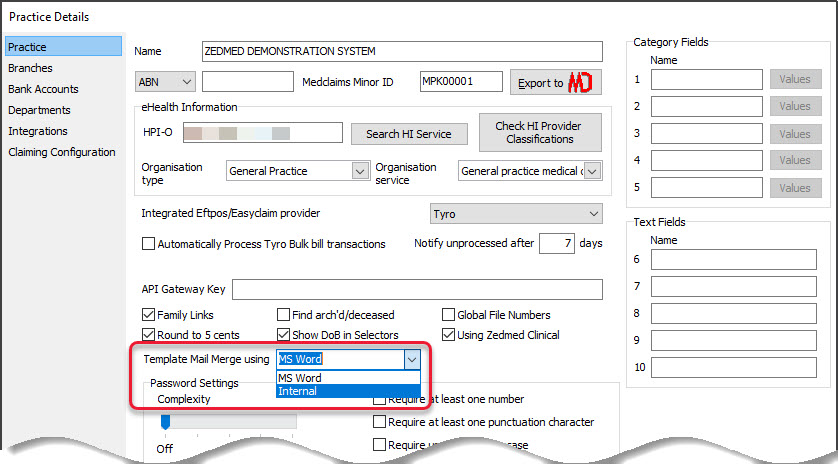
- Select Close to save and exit.
Note: Zedmed's Print Mapping Setup screen (F5), has a drop-down field for Label Printing Method with the options: Internal or MS Word. This only applies to the 2 Office templates with the word 'Internal' in their name - they need 'Internal' selected to print correctly. This setting is not related to the type of editor you are using and does not need to be changed.
Create custom FRM templates
Zedmed includes a set of standard templates, and you can edit these templates to create custom versions. For letters, forms and the mail merge templates used by some reports, the process is explained below. For labels, the same process applies but the mail merge steps are different and explained in the next section.
Note: These steps change an existing template. They do not make a copy of a template or change its name. This is because Zedmed looks for specific templates by name to apply them. You can copy a Zedmed template in Windows, rename the original, and give the new template the name used by Zedmed, but this is often unnecessary and can overcomplicate the process.
To customise a template:
- Go to Zedmed's Management tab.
- Select WP Setup > FRM Documents.
- Select the template tab required:
- Letters - to be used with the Office letter writer.
- Mail Merge Documents - to format Office reports.
- Labels - to print patient and appointment labels.
- Forms - to print out patient details.
- Select an existing document to use as a template.
- Select Open.
Microsoft Word will start.
- Select Yes to the warning prompt to run the SQL command.
- Select Link data source then the link dialog opens.
Browse to find and select the data source template for the FRM template you are copying. Data source templates are Word documents with the mail merge functions used by the FRM template.
For example, if you opened "FRM Referral Letter 2", you would locate and select "DS Referral Letter 2".
FRM templates and DS documents are both stored in the C:\Zedmed\Document and C:\Zedmed\Label After you link the DS template, the FRM template will open in Microsoft Word.
After you link the DS template, the FRM template will open in Microsoft Word.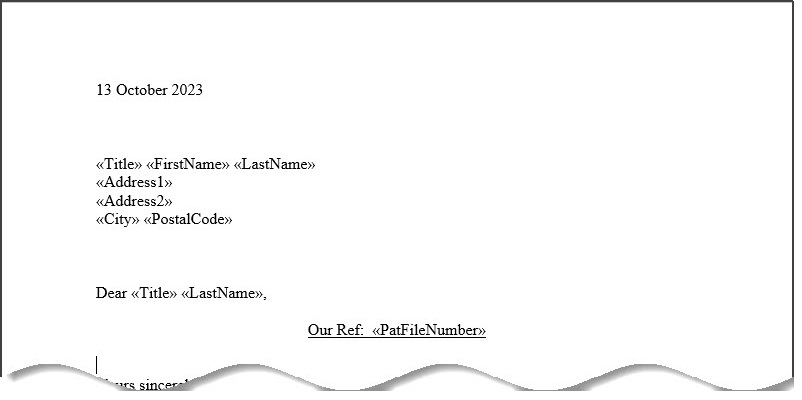
- Make the required changes to the template.
To make Mail Merge changes for labels, see Label mail merge. - To make Mail Merge changes for letters and reports:
- Check that Use the current document is selected for Mail Merge.
- Select the Mailings ribbon.
- Select Start Mail Merge > Step-by-Step Mail Merge Wizard.
- Follow the wizard to make the changes required.
- When you have finished, save the updated templates.
- Test that the template reflects the intended changes.
For example, if you updated a template to add text to a letter, use the Letter writer to confirm the new text appears.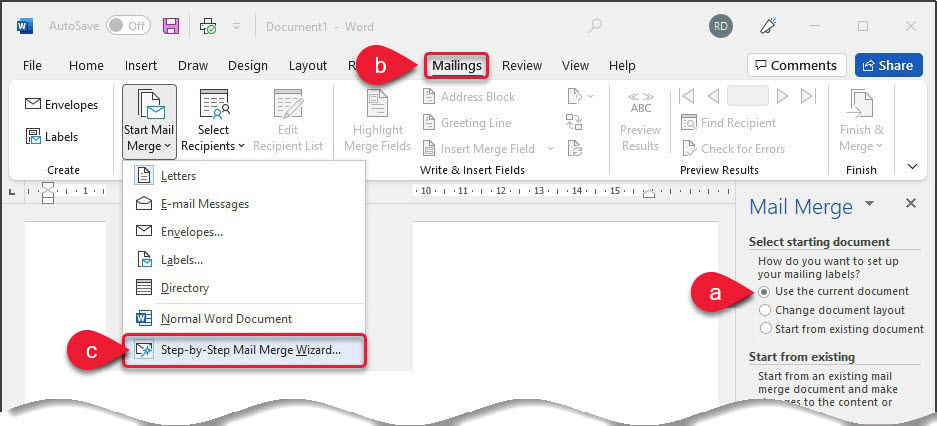
Mail Merge for FRM label templates
When creating a custom label:
- Follow the steps 1 to 6 in the section above.
These steps will open the label template in Word. - Press CTRL & A on your keyboard to highlight the template and copy it so you don’t lose it when the label type is changed.
- Select Mailings > Start Mail Merge > Labels.

- If you use a label printer like a Dymo, tick the Continuous Feed Printers option.
- If you print a sheet of labels through a standard printer, select Page Printers then select the appropriate tray.
- To set the Label information, you will need the label’s international code or product number.
This is normally found somewhere on the sheet or the label box. - Select OK once complete.
- When you close out, you'll get the following popup:

- If you have copied the template earlier, click OK.
- If you didn't copy the template earlier, select Cancel, then copy everything & go back to the Label settings.
The original label template will get deleted out. - Right-click in the box & select Text Direction
- Select the horizontal option then click Ok.
- Right-click in the box again and from the Paste options, select Keep Source Formatting.
- Make any adjustments required.
Merge fields can be accessed from the same spot as the other templates; Mailings > Insert Merge Field. - When complete, select Close and Yes to save.
Note: If the Label templates are renamed they will not print. Zedmed looks for specific template names like "FRM Standard Patient Label.doc" when you select a template from the print menu.
Create custom RTF templates
RTF templates were introduced in Zedmed v36.2.0 for Zedmed Cloud and RDP users who do not have access to Microsoft Word. All standard Word templates are provided in the new RTF format, but if you created custom templates in Office, you will need to recreate those templates using the RTF editor.
Letter Templates
There are no Letter templates for the RTF editor. Instead, Clinical's Batch writer is used to write letters and is Zedmed's recommended letter writer for both RTF and FRM sites due to the Data Tool's functionality. To create custom Letter templates, see the Managing Clinical Templates guide.
Label templates
Most custom Word templates that need to be recreated in RTF will be for labels. The steps below explore the functionality available for making custom templates of Reports (Mail Merge), Labels and the Patient Details Form, so there is a dedicated quickstart just for labels.
Custom template considerations
You can create custom RTF templates using the following options:
- Edit: Edit an existing template and save it with the same name - shown in the steps below.
- Duplicate: Create a duplicate of an existing template, save it with a unique name then edit it.
- New: Create a blank template, manually add information and save it with a unique name.
The steps for Edit, Duplicate and New are very similar. Edit is used in the steps below, with notes added for Duplicate or New.
To create a custom RTF template :
- Go to Zedmed's Management tab.
- Select WP Setup > Maintain Templates.
The Maintain Office Template screen will open and show 3 tabs:- Mail Merge Documents - to format Office reports.
- Labels - to print patient and appointment labels.
- Forms - to print out a patient's details.
- Select the template tab required.
- Select an existing template.
- Select Edit.
When you select Edit, the Edit Office Template screen will open. The Save button is greyed out until something is changed.
If you are making a New or Duplicate template:
a) Give the template a unique name.
b) Select the Type to determine what document or label will use this template in Zedmed. - Check the Visible check box selected.
This will show as Y or N in the Visible column and determines if the template appears as an option for Mail merge or Labels.
If there are multiple templates with the same type and all of them are active, the first one on the list will be used.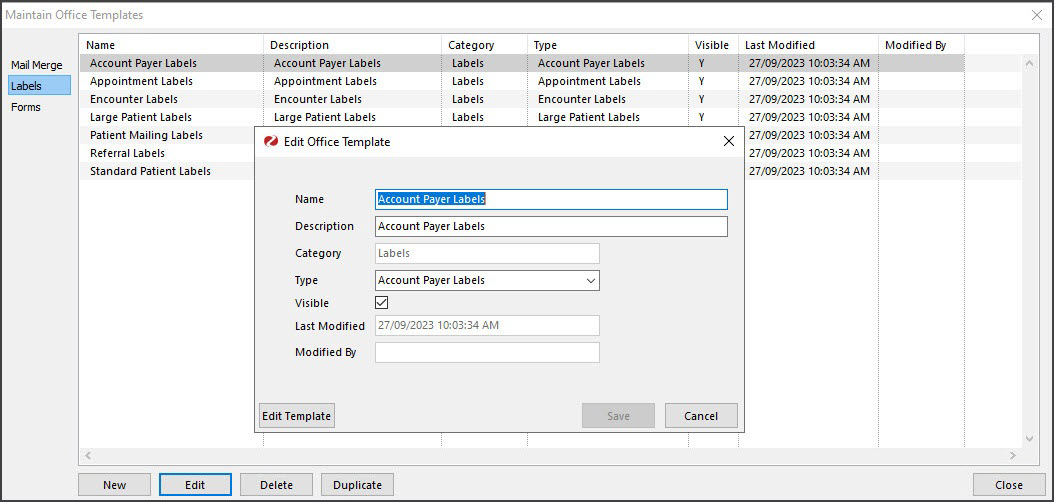
- Select Edit Template.
The template will open in the Zedmed RTF editor.
The example below is for a Label.
Forms and Mail Merge tab templates will show clinical and demographic options in the Data Toolbar.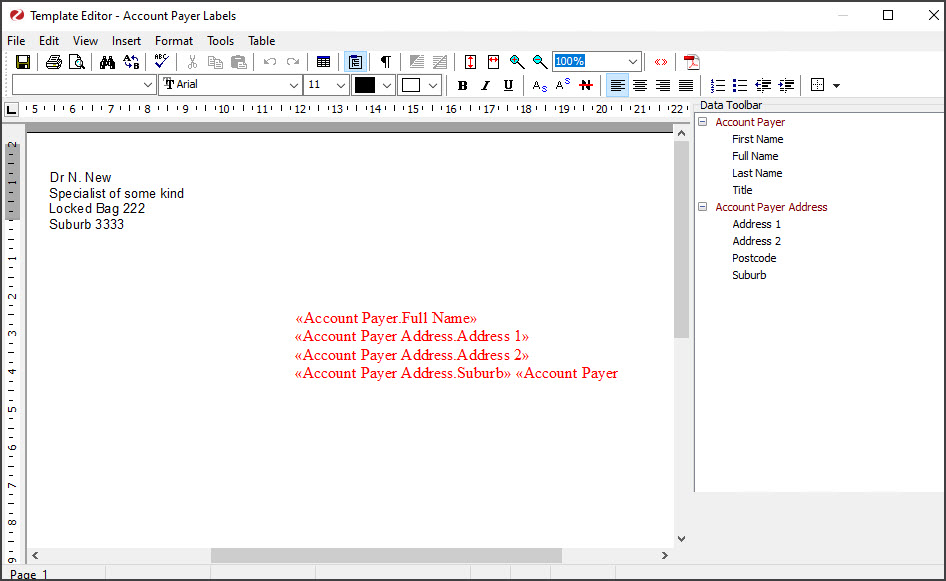
- Make the required edits to any information in the template.
You can delete existing data fields and add new ones. - To use the Data Toolbar to add data fields:
- Locate the information by expanding the categories.
- Select a space on the letter.
This is where the information will be added from the Data Toolbar. - Double-click the category item you want to add.
- When you have finished, select File > Save then File > Close.
- Select Save again on the Edit Office Template screen.
- Test that the template reflects the intended changes.
For example, if you updated a template to add text to a letter, use the Letter writer to check that the new text appears.
Quickstart for RTF label templates
This guide explains how to locate an FRM label template's settings and apply those settings to a new custom RTF label template.
Below are the two features that use label templates:
- Patient Record: Print > Label menu has a set of 4 labels. These are linked to the 4 default label templates in Zedmed.
- Appointment Details: the Print Label button uses the Appointment Labels template.
Step 1: Check the original label template you want to recreate.
In this section, you will open and record the settings used in the custom FRM (Word) template will recreate.
- Make sure Word is set as the template editor for Zedmed.
- Select WP Setup > FRM Documents and open the Label template.
- Select the Labels tab.
- Open the custom template.
Respond to the prompts and the template will open in Word. - Note down the font and font size. Check each line for any differences.
- From the template, select File > Page Setup.
This will open the Page Layout. - Note down or screenshot with width, height and margins.

Step 2: Create a new RTF label template.
In this section, you will create a new label and add the required data fields (similar to mail merge fields)
Important: when you create a custom RTF label, the template may show a single label's contents spread across 3 or more labels. This is expected and correct, as long as it only prints out on one label.
- Change the Zedmed template editor back to RTF.
- Select WP Setup > Maintain Templates.
- Select the Labels tab.
- Select New.
The New Office Template screen will open.
You could also Edit an existing template. This is recommended for complex templates that are variations of standard templates.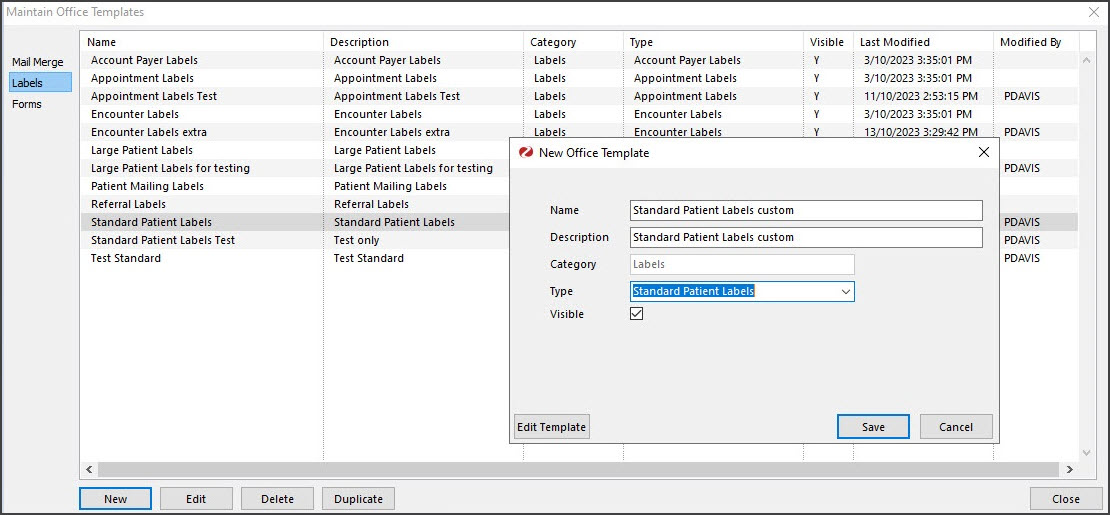
- Give the template a unique name.
- Select the Type to determine what Label menu item will use this template.
- Confirm that the Visible check box is ticked.
- Select Edit Template.
A blank template will open in the editor. - If you need 2 columns for the template's layout, insert a 2x1 table using the Create Tabel icon. If you require a more complicated grid, we recommend creating a duplicate of an existing template similar to your requirement and editing it.
- Use the Data Toolbar to add the required fields:
If you are editing an existing template, you can also delete fields.
a) Locate the information by expanding the Data Toolbar categories.
Select a space on the letter.
b)This is where the information will be added from the Data Toolbar.
c) Double-click the category item you want to add.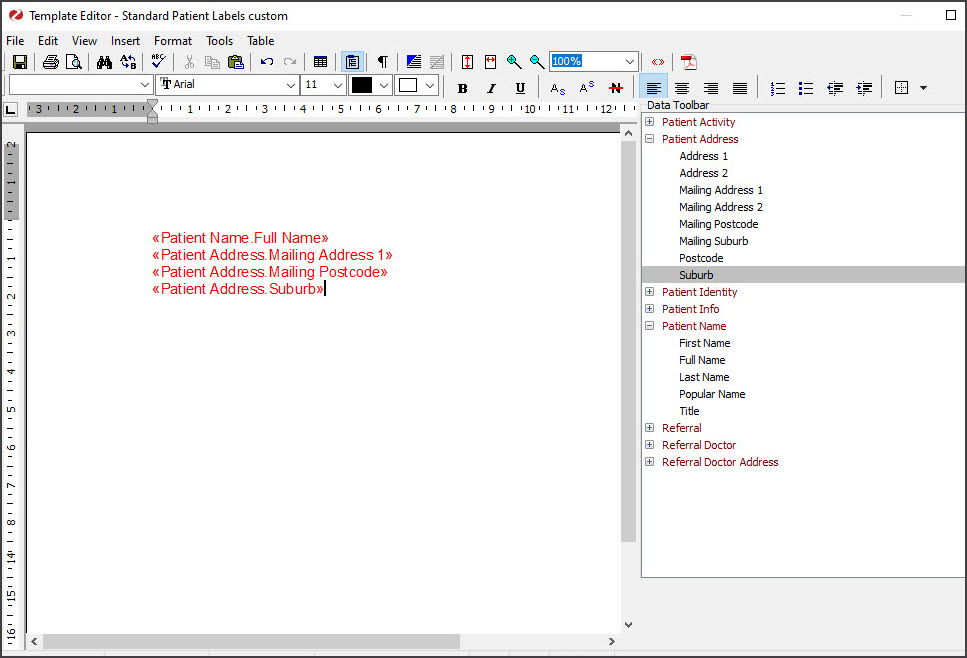
Step 3: Apply the settings to the new RTF label
In this section, you will review the setting so the label prints out correctly.
- Click on each line added and check the font and font size shown in Word.
In the screenshot above, it shows "Arial 11" - If the font or font size is different to the size in the original template, change it to match.
E.g, if the original was Arial 9pt and the Toolbar added size 11pt, select the text and select 9pt Arial font. - Select File > Page Layout.
- Check the settings you noted in Step 1 are the same:
- Check the paper size.
- Check the Width and Height
- Check the Margins
- Select Landscape for the Orientation. This will be different to FRM templates, which use Portrait.
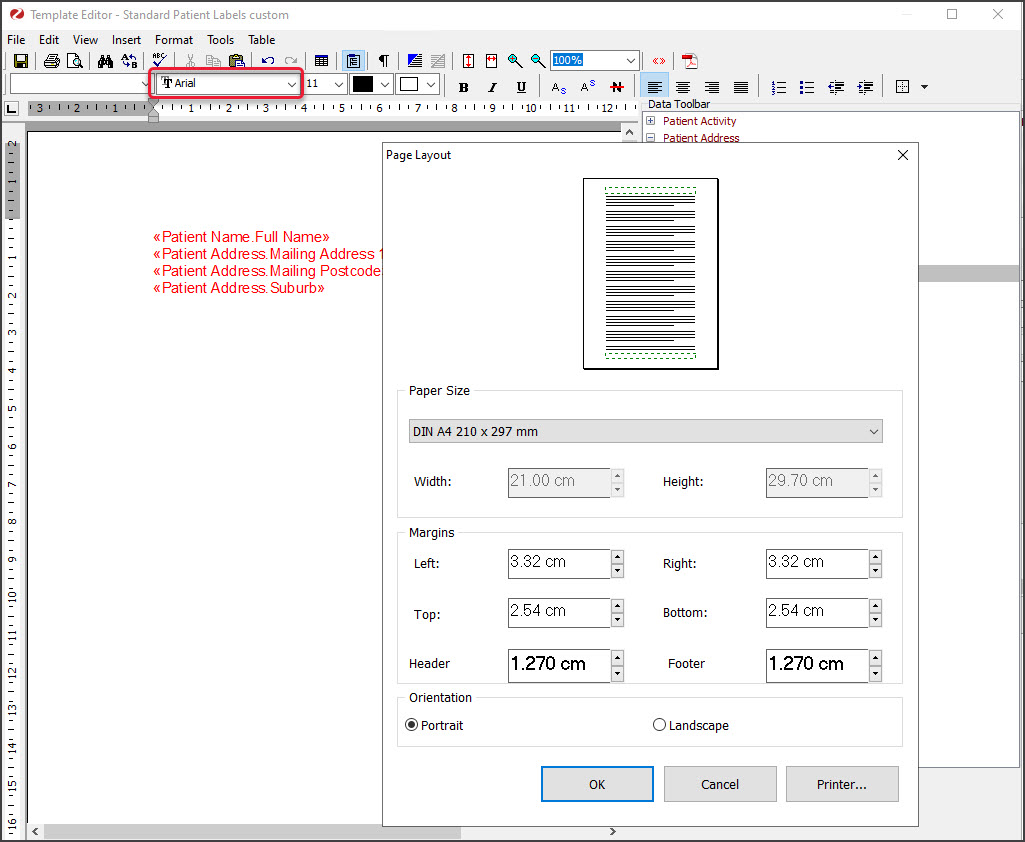
- When you have finished, select File > Save then File > Close.
- Select Save again on the Edit Office Template screen.
Note: some labels will use 3 or more label displays in the template. This is fine as long as the label only prints on 1.
Step 4: Name and test print the new RTF label
In this section, you will check the label template name and make sure it prints correctly.
- Confirm that the custom template has the same name as the standard template it replaces.
If required, use the Edit button to rename the template you copied or the original.
For a Patient Record, each of the 4 Label options is linked to the template with that name and Zedmed only works with that name.
- Use the applicable Zedmed function to print the labels.
For example, if you created a custom Standard Label, select Print>Standard from the Patient Record. - Check that the label prints out correctly and only uses 1 label.
- If information prints across more than 1 label or if there is a blank label:
• Check the font size is not larger than the original template font.
• Reduce the margins or height in the Page Layout. - Trial and error may be required to finalise more complex labels.



 After you link the DS template, the FRM template will open in Microsoft Word.
After you link the DS template, the FRM template will open in Microsoft Word.










